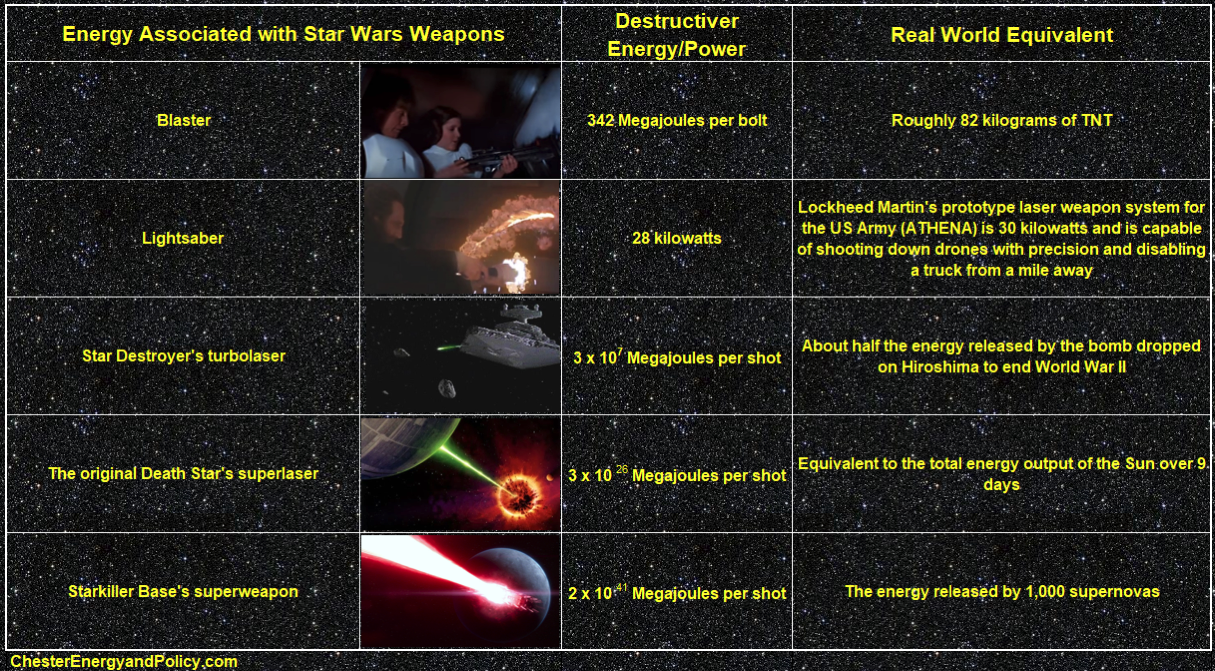Never Tell Me the Watts! Energy and Power Use in the Star Wars Universe
As is quickly becoming my favorite holiday season tradition, a new film in the Star Wars franchise is about to be upon us with the release of Episode VIII- The Last Jedi on December 15! Star Wars has officially been in the cultural consciousness for over 40 years, and as someone who has grown up at any point during those 4 decades, I am a huge fan. Among the many great aspects of a series so long-lasting and deep with rich canonical story-telling, be it through films, books, or video games, is the prevalence of debate it offers for the real-life implications of a fictional universe. Star Wars is the at the pinnacle of such analyses and debates– from economists calculating the cost to build the Death Star (an analysis even cited in an Official White House document) to scientists debating the reality of lightsabers— so it only seems right that this blog dives into the real-life energy implications of various notable Star Wars scenes.
Because Star Wars is so entrenched in pop culture, especially among young boys and girls who eventually become scientists, mathematicians, and engineers, many of these topics have already been explored from academic, scientifically rigorous, and painfully detailed perspective. As such, I chose to allow these crusaders of over-analysis do the digging for me and just cite their work instead of doing the number crunching on my own. Not only would it seem that the hours and immense attention to detail these people have poured into these questions would come to a much close answer to the ‘truth’ than my patience would allow me, but it also allows me to spend my anticipatory re-watch of the entire series without diligent note taking!
So strap in and take a tour of a galaxy far, far away as it relates to energy.
Preliminary notes
A couple important preliminary notes about the calculations cited and used below:
Certain questions have been analyzed be numerous people across various fields leading to competing answers to the Star Wars questions. For this exercise, I’m choosing to identify the conclusions that I find to use the greatest scientific rigor and attention to detail, as well as those that show their work and cite their sources. My goal was to find the closest to the ‘true’ answer as possible, but if you find a different number or calculation to be more accurate then I welcome the gloriously nerdy debate in the comment section below!
Source: Fox
It is also necessary to state that almost every data point going into the below calculations are estimates and approximations. Many of the numbers needed for the calculations simply aren’t provided in the source material, so these mathematical Jedi have resorted to options like determining size of equipment by comparing it to the known size of a human standing adjacent, analyzing the known energy required to melt certain earthen material and assuming the materials in the Star Wars universe are the same or similar materials, or even slowing down clips of the movies to get a frame-by-frame rate of speed. All that’s to say that the resultant numbers are estimates– diligently arrived-at estimates– but estimates nonetheless that do as good a job as possible at determining the relative order of magnitude. So take them with a grain of salt (which is better than a grain of sand, which is course and rough and irritating, not to mention it gets everywhere).
And lastly, with that grain of salt comes another huge one– I know these are movies. They are fictional, the directors often care more about how cool a scene looks instead of how it might break the law of physics, and the small details we analyze were probably not overly scrutinized for adherence to reality. These things don’t matter, but who cares? They are fun to think about and talk about and add depth to one of the greatest sagas in pop culture– so don’t strain yourself thinking too hard about them!
Source: Slate
Power required for uses of the Force
Emperor Palpatine’s Force lighting
Description: A number of times throughout the saga, we see Palpatine use his Force lighting, a unique aspect of his Force abilities. In the conclusion of Episode VI- Return of the Jedi, he uses the Force lightning on Luke after Luke once again refuses to join the Emperor on the Dark side and replace Darth Vader as his apprentice (click here for a YouTube link to the scene in question).
Calculation: This calculation is a rather tough one, but we do gain several clues from the scene, as pointed out by Joshua Brown.
The first clue is Luke’s reaction while being struck with the Force lighting, as he is able to call out in a plea for help, and though he is in obvious agony the attack is not fatal. Based on the science of the effect of electricity on the human body, this reaction from Luke would suggest he was experiencing between an AC-3 or AC-4 injury from the Force lighting. Given the evidence that the longest continuous length of time that Luke was being struck exceeded 10 seconds, the below chart would suggest the current coursing through Luke’s body likely didn’t exceed 30 milliamps (mA).
Source: Quora
With the current of the Force lighting in Luke’s body established, the other piece of data we would need is the resistance of Luke’s body– which we can assume is about 100,000 Ohms, the upper limit for the internal resistance of the human body (Luke is a trained Jedi, after all).
Referencing our high school physics textbooks, we’ll remember that power equals current squared times resistance. Plugging in a current of 30 mA and a resistance of 100,000 Ohms gives a Force lighting power of 90 Watts.
Real World Comparison: To put that power in perspective, 90 Watts is about the upper limit for power adapters for Macbook laptops. Surely you don’t want that much electricity coursing through your body, but it’s also an amount of power we routinely carry around in our backpacks.
This amount of power might not seem like much, but watch the scene again and consider whether it truly looked like the Emperor was using all his strength to kill Luke– or was he instead using just a portion of his powers to torture Luke as a message to Luke and/or Darth Vader? It also does end up being a deadly amount of power, as it serves as enough to knock out the electronics of Darth Vader’s life-supporting suit and causes his death.
Darth Vader Force choking and throwing into the ceiling a Rebel trooper
Description: Among the many aspects of Darth Vader that makes him such a menacing presence is his combination of raw power and his tendency to use that power to intimidate those weaker than him. This combination is displayed each time he uses the Force to choke a subordinate or adversary without ever laying a finger on them. This power was on display in the final scene of Rogue One, as he laid waste to a number of Rebel troopers who stood between him and the stolen plans for the Death Star, with one poor trooper being lifted and slammed against the ceiling in a fit of rage (one of the biggest on-screen payoffs in Star Wars films, in my opinion, which can be watched here).
Source: Lumiere
Calculation: Rhett Allain, a physics professor, analyzes this scene for Wired to determine the power of this demonstration of the Force. Allain has to make a couple of assumptions and educated guesses– namely that the Rebel trooper is the size of an average man (1.75 meters tall and 70 kilograms in mass) and that the gravity inside the ship is the same as gravity on Earth at 9.8 Newtons/kilogram.
With that information, Allain then uses a video tracker on the scene to determine that the trooper is lifted up to a height of about 1.5 meters in 0.46 seconds at a constant speed of about 3.3 meters per second.
Time once again to employ the high school physics text book to find that the total work done is calculated as the change in kinetic energy (0.5 times mass times velocity squared) plus the change in potential energy (mass times gravity times height). Plugging in the values listed gives a total work done of 1,410 Joules, which when divided by a time of 0.46 seconds gives the total power output of 3,065 Watts.
Real World Comparison: To put the power output of 3,065 Watts, or about 3.1 kilowatts (kW), in perspective– consider that 3.1 kW equates to about 4.1 horsepower. Commonly found outboard engines for small motorboats, such as this one, are rated at 4 horsepower as well– so at a moment’s notice Darth Vader is summoning the strength of a small motorboat. While that again doesn’t sound particularly scary, the clip shows the effect that this amount of power output can have when put in the wrong (robotic) hands.
Yoda lifting an X-Wing out of the swamp
Description: In Episode V- The Empire Strikes Back, Luke visits the planet of Dagobah to train with Master Yoda. Seeing the small stature and confusing training tactics, Luke begins to doubt the power of Yoda and question whether he is benefiting at all by being there.
Source: Quora
Disappointed by Luke’s insolent attitude and lack of faith in the training process, Yoda provides one of the greatest raw feats of Force strength we’re shown in the films– lifting Luke’s crashed X-Wing ship out of the swamp and into the air using the Force alone (again, the scene in question can be found on a YouTube video).
Calculation: Randall Munroe tackles the question of how much power Yoda outputs in this scene in his ‘What If?’ series. Munroe starts with a series of important assumptions, namely that:
The X-Wing is about 12,000 pounds (based on the weight of an F-22 fighter jet and the relative lengths of an F-22 and an X-Wing, Munroe scales the weight of an F-22 down to the proportional weight of the X-Wing), and
The gravity on Dagobah is 90% the gravity on Earth (according to sources on the highly detailed, extensive, and canonically accurate website Wookiepeedia).
Munroe then also broke down the video of the scene on a frame-by-frame basis, determining that Yoda lifted the X-Wing to a height of 1.4 meters in 3.6 seconds.
By plugging all these numbers into the equation power = mass times gravity times height divided by time, we find a power output of 19,228 Watts.
Real World Comparison: Sticking with the horsepower comparison, this power of about 19.2 kW equates to about 26 horsepower. What’s the first hit on Google when looking for a vehicle that’s 26 horsepower?
Sense in you much fear, do I?
Summary
Energy Associated with Star Wars Weapons
Lightsaber
Description: Lightsabers are the first and foremost among weapons you think of when you think of Star Wars, possibly of sci-fi in general. They are weapons mastered by Jedi and replicated by kids everywhere for the last 40 years. Lightsabers really don’t need any introduction, but the scene that is used to calculated the power of a lightsaber possibly does– as our best data points for lightsaber power use come from an early scene in Episode I- The Phantom Menace.
In the scene in question, Qui-Gon Jinn uses his lightsaber to get through a thick, metal door– first he makes a significant cut in the door, and then he sticks his lightsaber into the door for a period of time that allows it to melt a hole in the door (here is a clip of that scene that is for some reason repeated for an entire hour). This quick scene was enough to send Star Wars sleuths to the whiteboards to calculate the power output.
Calculation: For this calculation, we again to look to Rhett Allain at Wired who uses this scene to determine the power needed for a light saber. This calculation is the most complicated yet, so I would urge you to read the full article to learn more. But in summary, Allain uses the color that the door changes to as it heats up, the dimensions of the cut that Qui-Gon cuts initially, an assumed set of material characteristics for what this door was likely made out of, and the total time taken to make that cut. Put them all together using equations that would require your graduate-level physics books this time, and you get a power requirement of 28 kilowatts.
Real World Comparison: Rather than looking to the power outputs of an engine, it seemed useful this time to compare this power output to as similar a type of weapon as possible. As it turns out, Lockheed Martin created a laser weapon system for the U.S. Army that is rated at a comparable 30 kW. This Advanced Test High Energy Asset (ATHENA) system has proven capable of shooting down outlaw drones and disabling a truck from a mile away.
Source: CNBC
Considering the Jedi are carrying around that kind of power in a handheld weapon, you can understand the awe they inspire while expertly and effortlessly wielding lightsabers.
Blaster
Description: While lightsabers get all the buzz, Han Solo is famously quoted as saying that those “ancient weapons are no match for a good blaster at your side.” For the non-Force sensitive players in the Star Wars universe, blasters are the go-to firearm and are thus the most commonly used weapon in the galaxy, according to Wookieeepedia.
Source: Wired
To determine the energy of a single blaster bolt, the team at Ebates analyzed an escape scene in Episode IV- A New Hope where Princess Leia takes a blaster and shoots a hole through a metal grate for her, Luke, Han, and Chewbacca to crawl through. Not only does Leia succeed in winning the audiences heart by showing that this Princess is no damsel in distress (toward the end of this YouTube clip), but she also gives us the evidence needed to estimate the destructive energy of a single blaster bolt.
Calculation: According to the numbers crunched by eBates, the shot with the blaster created a hole about 3 feet in diameter in the metal grate, seemingly by vaporizing the metal. Estimating the dimensions and density of the metal that was vaporized (about 54 kilograms) and knowing the energy needed to vaporize a kilogram of iron (6.34 Megajoules) leads to a rough conclusion that the blaster shot yielded about 342 Megajoules.
Real World Comparison: Because the result of the blaster bolt here appeared to be a literal ‘blast’ of energy, it would be useful to know what would be required to yield the same explosive blast in the real world. Luckily, a unit of such destructive energy is standardized by the gram of TNT and is directly convertible to and from joules (one kilogram of TNT yields 4.184 Megajoules). Thus for our lovely Princess to have blasted through the iron gate with the same energy of the blaster, it would have required about 82 kilograms of TNT.
Star Destroyer’s turbolaser
Description: The devoted fans at StarDestroyer.net took on the question of the energy from a shot by the empire’s domineering Star Destroyers. In terms of military might (outside of the megaweapons to be discussed next), the Star Destroyer certainly stands as one of the most intimidating shows of military force in any galactic fleet.
In one particular scene of Episode V- The Empire Strikes Back, a single blast from the turbolaser of the Star Destroyer is shown to clear asteroids right from its path. This show of firepower gives us a good idea of exactly how much destructive energy is contained in these blasts (watch in action in this YouTube clip).
Calculation: This calculation is another fairly in-depth and complicated one, so I would again recommend reading their entire write-up of the topic in full. However, the basic gist is that one bolt was able to instantaneously melt an asteroid (composed of the average asteroid composition) that measured on the order of 20 meters in diameter. Knowing the science behind the melting of such an asteroid leads to the calculation that the energy in a single turbolaser blast is 30 Terajoules or 30 million Megajoules.
Real World Comparison: A single shot of the Star Destroyer’s turbolaser has the destructive energy of 30 terajoules, which for context is about half the total energy released by the bomb dropped on Hiroshima to end World War II. Given that the Star Destroyer was releasing dozens of these shots over the course of its chase of the Millennium Falcon, you would understand why those being pursued might ‘have a bad feeling about this.’
Original Death Star’s superlaser
Description: The Death Star is the Ultimate Weapon of the Empire, the presence of which alone was enough to inspire fear and garner compliance from every corner of the galaxy. That fear is well-deserved because this awe-inspiring weapon was created to have the power to completely destroy planets.
Source: Syfy
That’s not some sort of hyperbole, as we saw in the scene of Episode IV- A New Hope when the Empire demonstrates the power and unleashes the Death Star to destroy Princess Leia’s home planet of Alderaan. This show of force gives us the information we need to estimate how much destructive power is unleashed with the superlaser of the Death Star (watch the clip here, trigger warning for anyone who may have had friends or family on the planet formerly known as Alderaan).
Calculation: Our friends at StarDestroyer.net also did the analysis on how much firepower was behind this blast from the Death Star. These calculations might be the most scientifically detailed yet, so definitely check out the full analysis. In the end, they used three different methods to estimate the energy of the weapon (calculating the surface escape velocity that would be required for planetary destruction, the constant gravitational binding energy that would need to be overcome, and the variable gravitational binding energy that would need to be overcome). Each of these calculation methods resulted in a final figure betweeen 2.2 x 10^32 and 3.7 x 10^32 joules. This range is a wide one in terms of an exact answer, but they are all in the same order of magnitude and thus inspire confidence in their approximate accuracy. For the sake of argument, we’ll go right in the middle and assume the energy of the Death Star is 3 x 10^32 joules, or 3 x 10^26 Megajoules.
Real World Comparison: We’re up at a level of energy that doesn’t have any real Earthly comparisons, as the total annual world energy consumption is on the order of 10^14 Megajoules– many orders of magnitude less than a single shot from the Death Star.
Instead we have to go, rather appropriately, into space. The 3 x 10^26 Megajoules of energy used to destroy Alderaan is equivalent to the total energy output of the Sun over the course of about 9 days.
Starkiller Base’s superweapon
Description; In the first film of the latest Star Wars trilogy, Episode VII- The Force Awakens, the Death Star gets completely outclassed as a weapon. The First Order takes the idea of a planet-sized battle station capable of wiping out a planet and inspiring fear-based obedience and cranks it up to 11, as their Starkiller Base is a superweapon built into a mobile planet that is capable of wiping out an entire star system.
Source: Fantasy Flight Games
In this scene that shows the first ever shot from the superweapon, the massive scale of the destructive energy being unleashed is evident and is used to wipe out five planets like they were never there– something never before seen in the Star Wars universe. The energy needed for this weapon is literally siphoned from the energy/plasma of a nearby star and then unleashing it in one blast. As you can imagine, this amount of energy is almost unthinkable.
Calculation: Jason Haraldsen, a physics professor, tackles the science behind Starkiller Base in a piece he wrote from the Huffington Post. Despite his conclusions that there are a number of aspects of Starkiller base that would be scientifically impossible (for one, Starkiller Base and its weapon are hosted on an ice planet– yet the harvesting of energy directly from a star does not end up overheating the planet or even melting the snow on it?) Haraldsen calculates the amount of energy that is needed to charge up the superweapon by converting the mass of the nearby star into pure energy. Keeping things way oversimplified, just converting the mass of the star to energy using E = mc^2 results in an energy output of 2 x 10^41 Megajoules.
Real World Comparison: If the Death Star’s energy required us to go from the Earth to the Solar System, Starkiller Base forces us to go on a galactic scale to find an energy equivalent. The 2 x 10^41 Megajoules of Starkiller Base’s superweapon is equivalent to the energy released by 1,000 supernovas. Talk about unlimited power!
Summary
Conclusion
Do the filmmakers put as much attention into the minute details as we fans do in splicing apart and analyzing those details? Probably not. But that’s fine because the debate can be fun and educational and open up our eyes a bit about the comparable calculations in the real world. While thankfully it seems unlikely that any ill-intended human will create a sinister weapon as destructive as the Death Star or Starkiller Base, let us not forget that sci-fi can and has influenced the imaginations in the real world– from President Reagan’s Star Wars missile defense initiative to the ever-increasing presence of droid-like robots in our life. So pay attention to any new inventions while you’re watching The Last Jedi, and let me know in the comments if you have any other Star Wars (or pop culture in general) energy-related questions you’d like to read about next!
If you enjoyed this post and you would like to get the newest posts from the Chester Energy and Policy blog delivered straight to your inbox, please consider subscribing today.
For some other analysis of how pop culture and energy overlap, check out the blog posts written on Stranger Things Season 1 and Season 2 and this post on pressing energy-related questions in the wide world of energy.
Sources and additional reading
BP Statistical Review of World Energy
Death Star Firepower: StarDestroyer.net
How Many Batteries Would It Take to Power a Lightsaber? Or the Death Star? infographic journal
How strong is the Emperor’s lightning attack?
In Which We Literally Calculate the Power of the Force: Wired
Lockheed Martin’s laser weapon takes down 5 drones in live-fire demonstration: New Atlas
Power Source for a Lightsaber: Wired
The Physics Behind the Starkiller Base in Star Wars: The Force Awakens: Huffington Post
Turbolaser Firepower: StarDestroyer.net
US Army gets world record-setting 60-kW laser: DefenseNews
What was the yield of the Hiroshima bomb? Warbird Forum













